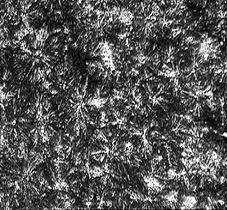A translucent heat-resistant polylactic acid composite material and its preparation method
A technology of composite materials and polylactic acid, which is applied in the field of translucent heat-resistant polylactic acid composite materials and its preparation, can solve the problems of lack of heat resistance, poor toughness of products, and influence on light transmittance, so as to increase the glass transition temperature and improve Heat resistance, the effect of good heat resistance
- Summary
- Abstract
- Description
- Claims
- Application Information
AI Technical Summary
Problems solved by technology
Method used
Image
Examples
Embodiment 1
[0035] A translucent heat-resistant polylactic acid composite material is prepared as follows:
[0036] ① Weigh 20 parts of polylactic acid, 1 part of cyclic phosphoric anhydride, 8 parts of 4,4'-difluorobenzophenone, 4 parts of sorbitol, 2 parts of dicyandiamide and 5 parts of polyvinylpyrrolidone in a high-speed mixer After mixing evenly, extrude and granulate in a twin-screw extruder at 150~210°C to obtain polylactic acid nucleating agent masterbatch;
[0037] ②Mix the polylactic acid nucleating agent masterbatch obtained in step ① with 80 parts of polylactic acid in a high-speed mixer, and then extrude and granulate in a twin-screw extruder at 160~205°C to obtain the present invention Translucent heat-resistant polylactic acid composite material.
[0038] Table 1 lists the mechanical property test results of the polylactic acid composite material obtained in Example 1.
Embodiment 2
[0040] A translucent heat-resistant polylactic acid composite material is prepared as follows:
[0041] ① Weigh 20 parts of polylactic acid, 5 parts of cyclic phosphoric anhydride, 2 parts of 4,4'-difluorobenzophenone, 1 part of sorbitol and 1 part of diethylene glycol diglycidyl ether, 3 parts of dicyandiamide and 2 parts Parts of polyvinylpyrrolidone are uniformly mixed in a high-speed mixer, extruded and granulated in a twin-screw extruder at 150~210°C to obtain polylactic acid nucleating agent masterbatch;
[0042] ②Mix the polylactic acid nucleating agent masterbatch obtained in step ① with 80 parts of polylactic acid in a high-speed mixer, and then extrude and granulate in a twin-screw extruder at 160~205°C to obtain the present invention Translucent heat-resistant polylactic acid composite material.
[0043] Table 1 lists the mechanical property test results of the polylactic acid composite material obtained in Example 2.
Embodiment 3
[0045] A translucent heat-resistant polylactic acid composite material is prepared as follows:
[0046] ①Weigh 20 parts of polylactic acid, 4 parts of cyclic phosphoric anhydride, 2 parts of 4,4'-difluorobenzophenone, 6 parts of diethylene glycol diglycidyl ether, 3 parts of dicyandiamide and 5 parts of polyvinylpyrrolidone After mixing evenly in a high-speed mixer, extrude and granulate in a twin-screw extruder at 150-210°C to obtain polylactic acid nucleating agent masterbatch;
[0047]②Mix the polylactic acid nucleating agent masterbatch obtained in step ① with 80 parts of polylactic acid in a high-speed mixer, and then extrude and granulate in a twin-screw extruder at 160~205°C to obtain the present invention Translucent heat-resistant polylactic acid composite material.
[0048] Table 1 lists the mechanical property test results of the polylactic acid composite material obtained in Example 3.
PUM
 Login to View More
Login to View More Abstract
Description
Claims
Application Information
 Login to View More
Login to View More - R&D
- Intellectual Property
- Life Sciences
- Materials
- Tech Scout
- Unparalleled Data Quality
- Higher Quality Content
- 60% Fewer Hallucinations
Browse by: Latest US Patents, China's latest patents, Technical Efficacy Thesaurus, Application Domain, Technology Topic, Popular Technical Reports.
© 2025 PatSnap. All rights reserved.Legal|Privacy policy|Modern Slavery Act Transparency Statement|Sitemap|About US| Contact US: help@patsnap.com


